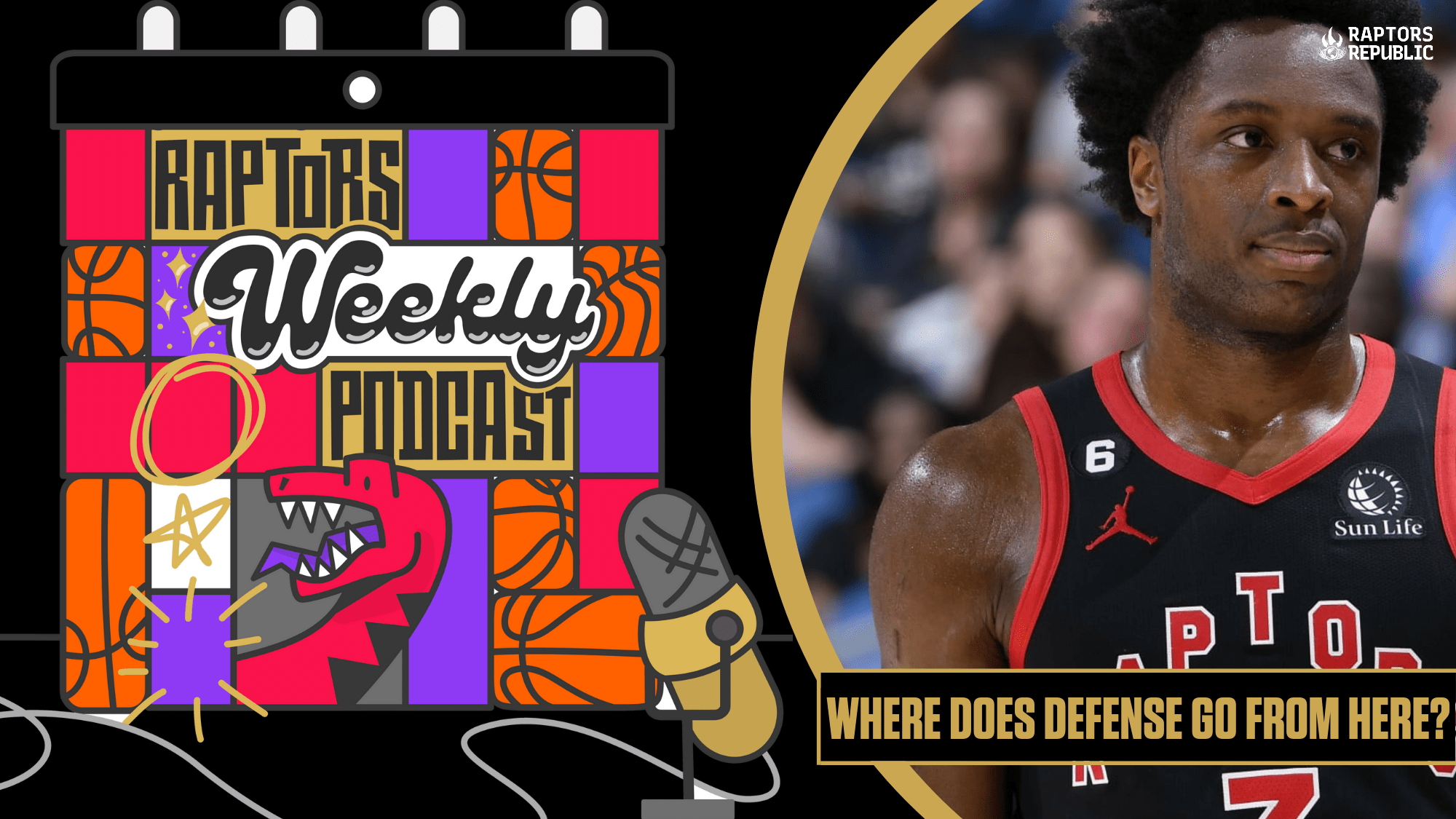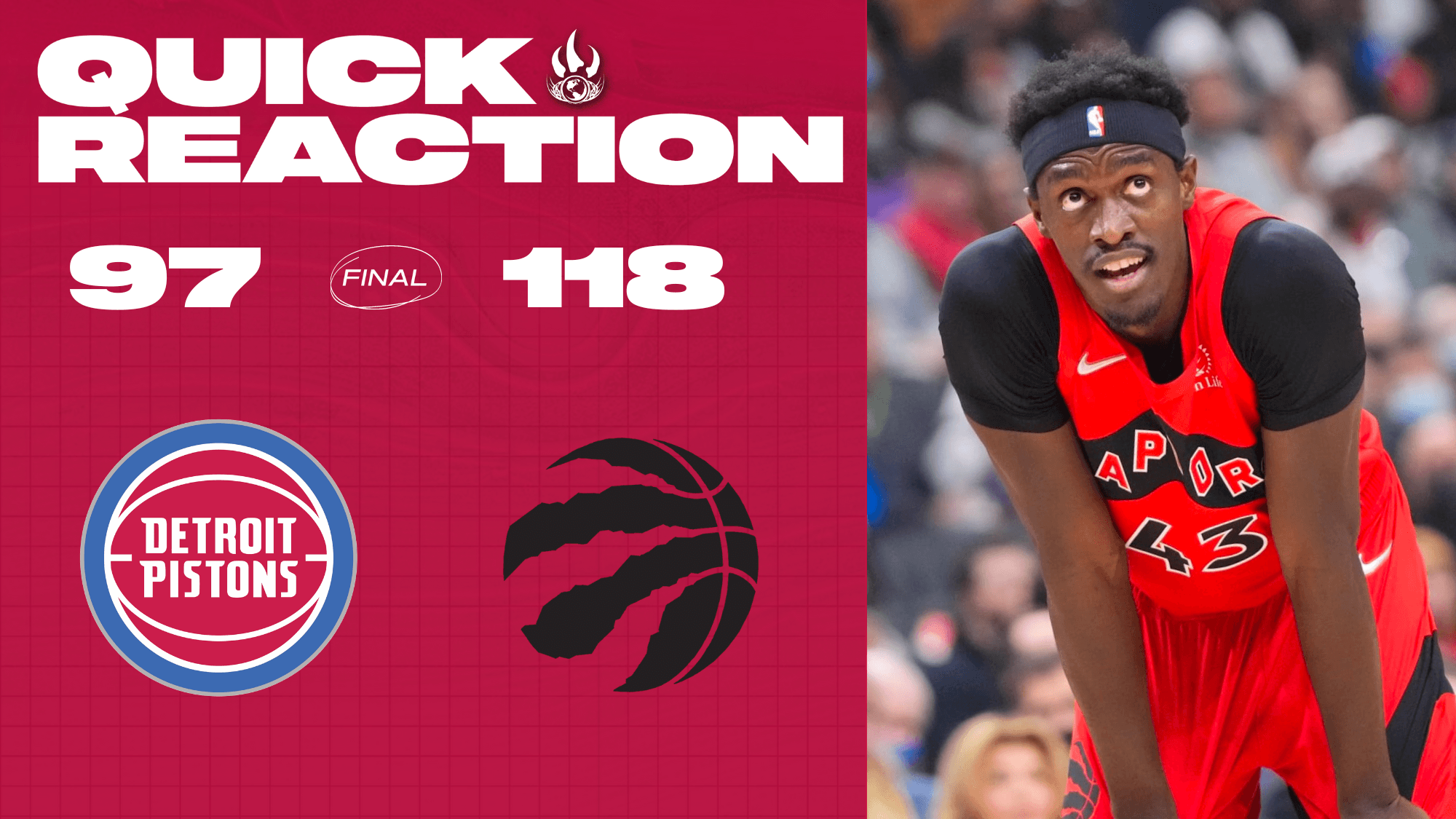Prepare for it.
Tie your loose ends. Call your bookie. Update your will. Do whatever you have to, because it’s set.
The Raptors, barring miracles, will do battle in the Play-In.
It looked for a moment that the much-much-much awaited rally was on its way with wins against Denver, OKC, and Minny. Nope.
Now, for us remaining optimists who look at each other dehydrated, starved, bedraggled sitting huddled, shivering on a raft cast out to sea, we wait and pray for the 8th seed.
Let’s roll.
1. TactiPöltls
Since Pöltl’s arrival, the Raptors roster has had much more certainty. Physically, psychologically, existentially. Kit n’Kabootle.
His size, particularly, has enabled the Raptors to rely mano e mano on defence more than their typical hysteric scrambles. He serves both as a backline beefeater in help situations, and in most matchups, will survive post-ups against greater or equal foes. No need for help.
Despite this backbone boon, twice now (I’m sure there are other examples), from what I count, Nurse has failed to ensure Pöltl’s minutes align with his counterpart, costing the Raptors grievously in short periods of time.
First, it was against the Clippers.
First quarter Pöltl and Clippers big, Ivica Zubac play and sit at exact time intervals. Second quarter, Pöltl and Zubac align, for the most part, again. Third quarter things change a tad. Zubac out at 4:19, Pöltl remains until 3:00.
Fourth quarter, the error is minor but significant. Zubac checks back in at 8:40, Raptors down 88-82, Pöltl continues to sit. A minute in Zubac secures several defensive boards and then an offensive rebound, is fouled on the put-back, and hits both free throws. Pöltl comes in a minute later with the difference grown to ten points.
Second time was against the Bucks with much worse consequences. Nurse did a decent job in the first quarter. Lopez subbed off at 7:05, Pöltl at 6:14. Lopez came back a minute and a half later, as did Pöltl. The moment Pöltl subbed out, however, towards the end of the first, Lopez immediately scored.
Second quarter, no issue, their minutes-logged identical. In the third, more or less the same as the first. Brook subs out at 7:15, Pöltl at 5:26.
Once again, it’s the fourth quarter where the timing blunder hurts the Raps. Toronto is up 95-91 to start the quarter. Lopez is on the floor; Pöltl sitting. First play, Lopez alley-oop And-1. Two possessions later, Lopez lay-up And-1. Two possessions after that, Lopez dunk, Bucks take the lead.
In comes Pöltl, damage already dealt.
The mistakes are minor. Subbing is never perfect. Still, in these tight games, where most teams have play[ins]offs in sight, matchups, runs, dryspells, rebound disparities, and bench battles, are what decide Ws from Ls. And, when Pöltl is the man you want matched up against the other team’s best big, not doing so with the game on the line, is a major tactical failure.
2. The Freddy V Qualm
Okay, this one’s been on my mind for a while.
Lou Zatzman wrote a terrific piece on why Freddy is not a selfish player. The crux of his argument based around numbers detailing Freddy’s usage, shots per possession, passes, touches, dribbles per touch, etc. All of it declaring he’s no different than most other guards in the league.
I felt yelled at by Lou. I’ve been a big, loud critic of Freddy’s style of play for most of the year.
MY QUALM, in case you were wondering, was not how infrequent Freddy passed, but when. That’s an observational thing, more than it is data. Cadence and timing something you intuitively feel and explicitly experience. Watching Freddy, I felt and saw stagnancy.
Moments where simple, easy passes were ignored or deferrals to others in other matchups missed. Freddy has earned the right to make these decisions: when he feels he’s best for the job, or not. And, to Lou’s point, having Freddy succeed Kyle Lowry is a profoundly difficult act to follow. He who made the decisive in an instant.
Kyle’s bullet swings and elaborate lobs defined his acumen and elite point guard play. He was a genius manipulator of the floor by vision. Not bending the force of the defence with whirling dribble combos but by seeing the vulnerability, or, even more delectably, foreseeing it.
So while I think Lou’s piece statistically demonstrated that Freddy is no worse than most in the league in ball dominance – for a guard – it didn’t answer my biggest qualm.
Until now.
3. The Freddy V Qualm Answered
In the last two months, Freddy has played the best basketball, in my opinion, of his career.
I’ve always wanted Freddy to be more Kyle Lowry than Chris Paul. There’s no doubt he can score. And for a team where that is rare, he needs to do a lot of it. It’s not where he’s best. This year Freddy’s at career highs for at-rim and midrange shooting percentage, which, in comparison to his point guard peers, is still a poor rate (32nd and 25th percentile respectively).
Getting by dudes is easy for Freddy. With a laser beam pull-up three in the arsenal one must always ward against the pop-and-drop. When he does find space, however, options greater than his own shots await.
It’s no coincidence, that Freddy’s best hoops has occurred with Pöltl’s arrival. Prior to Pöltl, Freddy averaged 6.5 assists and 16 shots per game. Since, 9.1 assists on the same number of shots and same usage rate.
It’s what Toronto has so desperately needed. A big who can send smashing screens and delicately finish at the rim paired with a guard who can not only score over top of defences, but intersect them, split them in two or three, and open avenues for others.
Less difficult step-backs, challenged middies, and scooping lay-ups. More drive and kicks, hitting the roller, and finding the elusive weakside cuts.
The Freddy-Pöltl screen and roll is probably Toronto’s best offensive option to date. Narrowly, followed by Pascal in isolation.
Out of it, Freddy is a major problem. The easiest choice is Pöltl tumbling downhill like a ballet dancing linebacker.
Look at the options available to Freddy. He receives the screen on an empty strong side. Three Raptors on the weakside. Freddy gets to the free throw line with Ben Mathurin completely taken out of the play by the screen. It’s an easy jumper should Freddy elect. Andrew Nembhard has to drop from Pascal to at least caution Freddy. Myles Turner too is worried. I’d say early season Freddy shoots it. Now, the dump pass to Pöltl is clockwork.
Truly, I’m not sure if anyone anticipated how much Pöltl would unlock Freddy’s playmaking. We can all recall the odd lob to Koloko or Precious off a screen-and-roll. It was novel, but not reliable with both having poor hands and scrawn bods. Pöltl, conversely, has incredible coordination and a big ol’ bod to back it up. Providing Freddy with a variety of ways to deliver the ball to Pöltl.
Naturally, as teams compensate, we’re seeing so much more open up for weakside shooters like O.G., Pascal, and Gary too.
Even without Pöltl, it has felt like Freddy has focussed on getting the ball to guys early and often. A trust and confidence in oneself and in others finally formulating. Quick and easy hits to open guys. An underrated action in all levels of basketball are the simple, easy passes. Think soccer and the reversal and then re-reversal of the ball back-and-forth across the field to open defences up. Same thing in hoops.
It’s simple, I know. It’s what was so wondrous about Kyle. It is also what this team – known as parts lesser than their sum – needs to achieve greater balance and optimization. Unsticky hands. Insistent movement. Timeless selflessness.
Freddy controlling the ball and this team has never been my problem. How and when he distributes – or not – the ball has. He’s struck a balance allowing for his own game to flourish while creating for others.
The re-signing of Freddy will be an incredibly contentious debate amongst fans. Age, cost, efficiency, etc. If he maintains this level of distribution and falls more comfortably into a lead point guard role, bringing him back (along with Pöltl) makes a Hell of a lot more sense than it did months earlier.
4. Jack of the People
Every once in a while I’ll fawn over Jack Armstrong.
It’s not really needed these days. He’s already a local favourite.
Hosting a charity event singing his favourite Christmas ditties. Leading Toronto’s St. Patty’s Day as the Grand Marshal. And, now, becoming an international topic of discussion after The Ringer‘s Danny Chau wrote about his success and charm.

So, I don’t have much more to say. Other than, what makes me happiest about Jack is that he’s a man of the people for the people. A jovial, self-deprecating, honest, loving socialist.
How do I know. Cause of this snarky little quip on the broadcast the other night.
In the first quarter of the Minnesota game, Matt Devlin was explaining how Fairleigh Dickinson, who eliminated Purdue in the first week of the Men’s NCAA March Madness, had not even won their own conference. That was Merrimack, but they didn’t qualify because they had moved up from Division Two to Division One, and teams that change divisions have to wait a year before they can compete in the Madness.
Makes little sense. Devlin stated they had to get rid of the rule, Jack went one step further:
“I’m more of a fan of what you said earlier. We need to get rid of the NCAA…”
They both chuckle. “It may happen, Jack.”
“Bureaucracy, utter nonsense. That’s all it is.”
“It doesn’t benefit the student athlete, that’s for sure.” Devlin trying to refocus the convo from evil profiteering corporation to innocent, sweet amateur, individual athlete.
Jack concludes, “No, a lot of people sitting around in tweed jackets making a lot of money.”
Boom. Nothing like an NBA broadcaster bluntly throwing shade at a multibillion dollar corporation on National TV. Particularly, when your employer is also a multibillion dollar corporation sidled up with said multibillion dollar corporation.
Jack dan’t care about dat gahbage. He’s just saying how it is. And, goddamn, it’s refreshing.
I lament the polished world. Popular culture – sports included – just rounded edges and bland flavours. No values, no truth, no dissonance. It’s why Twitter convulses when KD says something on his mind. Or, when all of the world is more upset about Will Smith slapping a dude than some dictator eviscerating their people. Right or wrong, expectations, in pop culture, are denuded reactions and Brave New World smiles.
We all suffer for it. Us new generations starve for mentorship. For people to tell us how and why things are and to give a hand towards our own true discovery. Lisa Miller of the Intercepter wrote a fascinating piece on the piece of shit Andrew Tate. In it, among other things, she talks about, mostly, young white boys, who feel voiceless. No space to discover themselves, to be idiots, to experiment with values and their nubile understanding of the world. Confined and repressed by the deconstruction of a white elitist patriarchy that, they too, ironically, are victims of…by the way.
Tate filled that void. With horrendous consequences.
Jack’s no generational hero. No philosopher either. He’d be the first one to admit it. But he symbolizes what is needed for our younger generations. Someone who – kinda like Shaq and Charles Barkley – while cumbersome and, often, ignorant, humbly (okay, not so humble by Shaq and Chuck, but you know what I mean) speaks their mind and avoids kowtowing to the suits looking on down with pay cheques in hand.
To me, these old fogies pave the way for a smarter, more enlightened generation who are now, finally, pushing back against the idiocy, platitudes, and elitism of NBA media. Taylor Rooks, JJ Reddick, Bomani Jones, Malika Andrews, Pablo Torre, Chiney Ogwumike, and so on, are revolutionizing sports commentary. They’re fun and honest and argumentative.
And while we wait for local broadcasts to also catch-up – KIAAAA NURRRRSEEEE. Man, is it refreshing to hear a mainstream media person just say it how it is. An unfiltered voice thrusting sharp words at greed, injustice, and the nonsense of image, all while giving us a nice chuckle and a few insights on the game of basketball.
5. O.G. Up
O.G. is back, baby!
Took a while. A course of shooting peaks and valleys.
It looked like he’d found rhythm again, and then WHOMP, falls on his wrist and has to sit nine games.
Upon returning, he’d lost the flow again. And, now, he’s back, baby!
The three was inevitably coming back. He’s too good of a spot-up shooter. Especially, from those corners.
The mid-range is what’s been cooking and vital to his game’s growth.
Up until March 3rd, O.G. was shooting 32% on pull-ups – predominantly in the mid-range. Since then, in 9 games, 57%!
All shooting percentages are up for O.G.: at-rim, three-point, and mid-range. Lou outlined that in great detail. The mid-range pull-up is the most important.
O.G. has trouble, still, creating separation one-on-one. He’s forced the issue less of late – to all fans’ relief. When he has attacked, the step back has been the most effective in getting open. He was missing them earlier in the season. Now, he’s not.
The step-back is very difficult to guard. O.G. has so much power both when creating contact with the defender and in the actual stepping back. Defenders are anchored. The divide between them and O.G. a continental rift.
O.G. receives a pretty poor set of screens from Gary and Precious. Kris Middleton fights through and remains on O.G.’s hip. It’s a bit of a push-off, but look how much room, O.G. creates. Middleton nearly crumples backwards from the hit.
Again, against one of the best defenders in the league in Anthony Day-to-Day Davis, O.G. creates just enough contact to get AD on his heels. It’s a tremendous fadeaway.
This is a more promising possession. O.G. receives a pindown from Koloko, fakes a handoff, and receives another screen from Koloko. SlowMo Kyle Anderson, knowing O.G. wants to straight-line drive, goes under the screen. O.G. crosses back against the screen into a very smooth pull-up that drops despite a good challenge from Josh Minott.
Knowing it’s coming, opponents will have to readjust their footing. For example, trying to avoid O.G.’s initial contact or to shadow the shooting hand more. DeMar, basically, gets beat. But you’ll see how he’s crowding O.G.’s hip and shoulder to enable a challenge from the side of the shot. O.G. would have more trouble pulling, so it’s a rim cram instead.
Ideally, for someone who struggles with balance and handles, O.G. will have an easier time countering defenders’ adjustments as they put themselves less square to O.G.. It shows more signs in O.G.’s slow build towards an offensive dynamism that O.G. and every single Toronto Raptors fan is craving.



